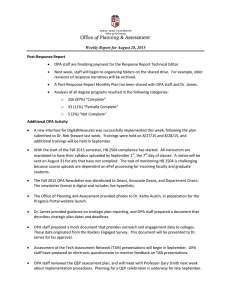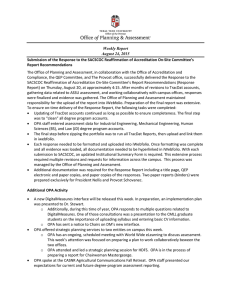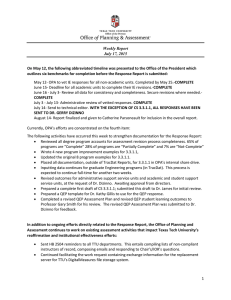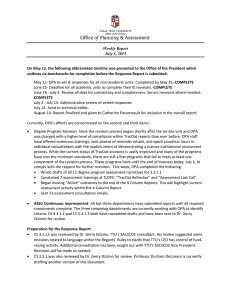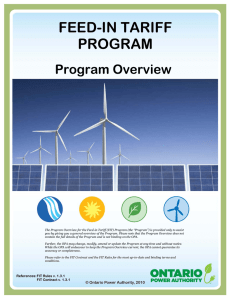OPA Support for Renewable Energy
advertisement
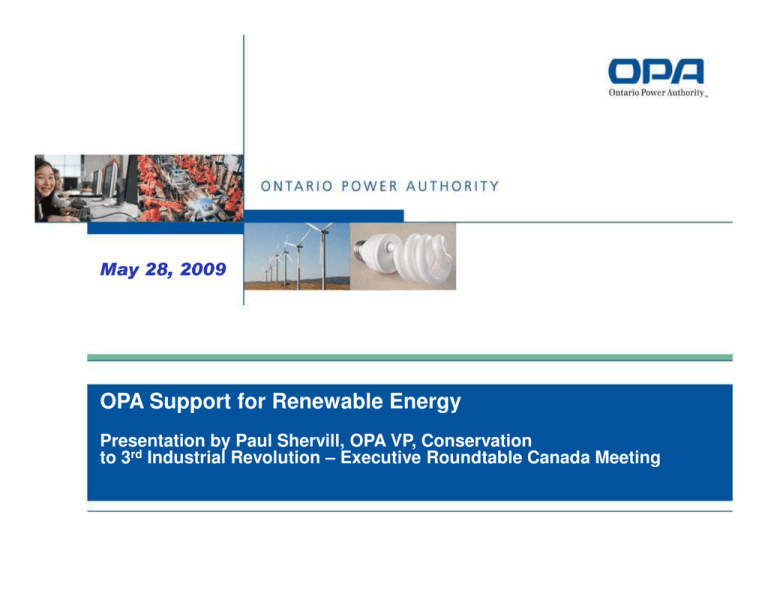
May 28, 2009 OPA Support for Renewable Energy Presentation by Paul Shervill, OPA VP, Conservation to 3rd Industrial Revolution – Executive Roundtable Canada Meeting The Ontario Power Authority • Mandate is to ensure reliable, sustainable electricity supply for Ontario • Functional areas: - planning - conservation - supply development 2 Overview • Feed-in Tariff Program for Ontario – Objectives – Key features – Pricing – Stakeholder Consultation • Areas of Coordinated Development outside OPA – Regulations – Renewable Energy Approval – Distribution Code – Local Distribution Companies 3 Culture of Conservation in Ontario Conservation the other important part of the Green Energy Act – #1 planning resource for the OPA Energy Conservation Week – creating a culture of conservation in Ontario – Count Yourself In! – take the pledge www.energyconservationweek.ca 4 Proposed FIT Program – Objectives • Increase capacity of renewable energy supply to ensure adequate generation and reduce emissions • Will help Ontario eliminate coal-fired generation by 2014 • Simpler method to procure and develop generation • Create new green industries through new investment and job creation • Provide incentives for investment in renewable energy technologies 5 Proposed FIT Program – Standardized Features • • • • • Will be North America’s most comprehensive FIT program Open to various renewable energy supply technologies Different prices for different technologies and project sizes Long-term, fixed-price contracts Prices that aim to cover total project costs and provide a reasonable rate of return over the contract term • Opportunities for promoting participation in projects by local community members and Aboriginal communities • Designed to require developer to undertake certain development work in advance of contract execution 6 Proposed FIT Program – Pricing • Pricing by technology and size • Prices aim to cover total project costs and provide a reasonable rate of return over the contract term • Opportunities for promoting community-based and Aboriginal participation in projects • Prices derived using recent market data, OPA experience with previous renewable energy contracts (RES, RESOP), experience in other jurisdictions and stakeholder consultation 7 Summary of Changes – FIT Price Schedule Technology Capacity Range Rooftop or Ground Mounted Solar PV Rooftop Solar PV Rooftop Solar PV Rooftop Solar PV Ground Mounted Solar PV On-shore Wind ≤ 10 kW Original Proposed Revised Proposed Price (¢/kWh) Price (¢/kWh) 80.2 80.2 71.3 63.5 53.9 44.3 Any size 71.3 63.5 53.9 44.3 (automatic degression) 13.5 Off-shore Wind Waterpower^ Any size ≤ 10 MW 19.0 12.9 / 20-yrs 19.0 13.1 / 40-yrs Waterpower^ Biomass Biomass Biogas Biogas Biogas Landfill gas > 10 MW ≤ 50 MW ≤ 10 MW > 10 MW ≤ 500 kW > 500kW ≤ 10 MW > 10 MW ≤ 10 MW > 10 MW > 10 kW ≤ 250 kW > 250 kW ≤ 500 kW > 500 kW > 10 kW ≤ 10 MW 12.2 14.7 10.4 11.1 10.3 13.5 12.2 / 40-yrs 13.8 13.0 16.0 14.7 10.4 11.1 10.3 All prices increase by CPI to the earlier of the Commercial Operation Date and the Milestone Date for Commercial Operation, then increase by 20% of CPI All technologies eligible for Aboriginal or Community Price Adder up to 1.5 c/kWh for up to 50% equity share (max. 1.5 for Aboriginal, max 1.0 for Community) ^ Contract term for waterpower projects proposed to8 increase to 40-years, therefore lower prices Stakeholder Consultation • 8 full-day sessions over nine weeks – Workshops from March 17 to May 12 – Each covered a different topic – 3 sessions for First Nations and Métis representatives • Q & A tool on OPA website – Responses to questions posted publicly – Could also submit comments and recommendations • Helped shape the program – Prices, draft program rules, contract 9 Coordinated Development Outside OPA • To ensure successful and timely launch of the FIT Program, the following areas are being developed in coordination with development of the FIT Program: – Regulations • OPA is working with government to identify (and potentially draft) key regulations needed for FIT Program launch • Key areas that may be covered by regulations – Domestic/Provincial content – Community funds – Aboriginal funds 10 Development Outside OPA (continued) – Renewable Energy Approval (REA) • Ministry of Environment is working with other ministries and agencies to develop one approval process • REA will be a key FIT contractual milestone – Distribution System Code (DSC) • Changes required to define cost allocation rules regarding distribution system expansion • Other DSC changes may include: – Distribution system planning/connection tests – Transmission Priority • OPA working with IESO, MEI and Hydro One to prioritize • Billions of dollars to be invested in both transmission and distribution to connect renewable energy 11 Role of Local Distribution Companies • OPA working with LDCs to define their roles and responsibilities in administering the FIT Program • OPA will also propose LDCs to settle applicable FIT contracts – Consistent with settlement of Renewable Energy Standard Offer Program (RESOP) contracts • LDCs will be required to produce plans to expand their distribution systems 12
